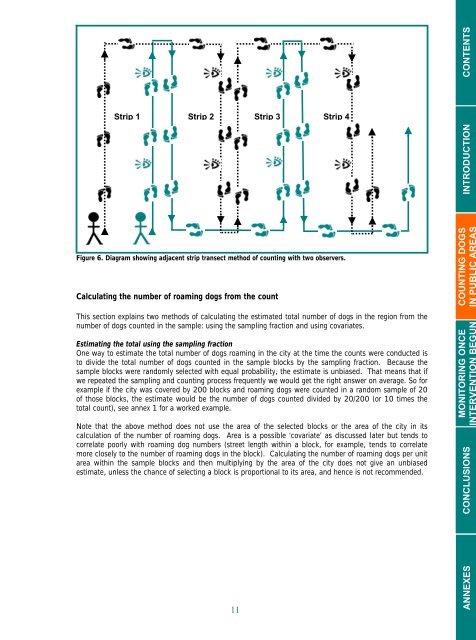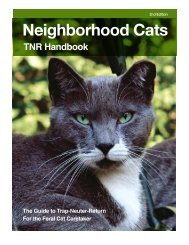Surveying roaming dog populations: guidelines ... - Animal Sheltering
Surveying roaming dog populations: guidelines ... - Animal Sheltering
Surveying roaming dog populations: guidelines ... - Animal Sheltering
Create successful ePaper yourself
Turn your PDF publications into a flip-book with our unique Google optimized e-Paper software.
Strip 1 Strip 2 Strip 3 Strip 4<br />
INTRODUCTION<br />
CONTENTS<br />
Figure 6. Diagram showing adjacent strip transect method of counting with two observers.<br />
Calculating the number of <strong>roaming</strong> <strong>dog</strong>s from the count<br />
This section explains two methods of calculating the estimated total number of <strong>dog</strong>s in the region from the<br />
number of <strong>dog</strong>s counted in the sample: using the sampling fraction and using covariates.<br />
Estimating the total using the sampling fraction<br />
One way to estimate the total number of <strong>dog</strong>s <strong>roaming</strong> in the city at the time the counts were conducted is<br />
to divide the total number of <strong>dog</strong>s counted in the sample blocks by the sampling fraction. Because the<br />
sample blocks were randomly selected with equal probability, the estimate is unbiased. That means that if<br />
we repeated the sampling and counting process frequently we would get the right answer on average. So for<br />
example if the city was covered by 200 blocks and <strong>roaming</strong> <strong>dog</strong>s were counted in a random sample of 20<br />
of those blocks, the estimate would be the number of <strong>dog</strong>s counted divided by 20/200 (or 10 times the<br />
total count), see annex 1 for a worked example.<br />
Note that the above method does not use the area of the selected blocks or the area of the city in its<br />
calculation of the number of <strong>roaming</strong> <strong>dog</strong>s. Area is a possible ‘covariate’ as discussed later but tends to<br />
correlate poorly with <strong>roaming</strong> <strong>dog</strong> numbers (street length within a block, for example, tends to correlate<br />
more closely to the number of <strong>roaming</strong> <strong>dog</strong>s in the block). Calculating the number of <strong>roaming</strong> <strong>dog</strong>s per unit<br />
area within the sample blocks and then multiplying by the area of the city does not give an unbiased<br />
estimate, unless the chance of selecting a block is proportional to its area, and hence is not recommended.<br />
COUNTING DOGS<br />
MONITORING ONCE<br />
CONCLUSIONS<br />
11<br />
ANNEXES








